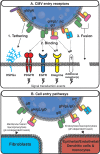Virion Glycoprotein-Mediated Immune Evasion by Human Cytomegalovirus: a Sticky Virus Makes a Slick Getaway
- PMID: 27307580
- PMCID: PMC4981668
- DOI: 10.1128/MMBR.00018-16
Virion Glycoprotein-Mediated Immune Evasion by Human Cytomegalovirus: a Sticky Virus Makes a Slick Getaway
Abstract
The prototypic herpesvirus human cytomegalovirus (CMV) exhibits the extraordinary ability to establish latency and maintain a chronic infection throughout the life of its human host. This is even more remarkable considering the robust adaptive immune response elicited by infection and reactivation from latency. In addition to the ability of CMV to exist in a quiescent latent state, its persistence is enabled by a large repertoire of viral proteins that subvert immune defense mechanisms, such as NK cell activation and major histocompatibility complex antigen presentation, within the cell. However, dissemination outside the cell presents a unique existential challenge to the CMV virion, which is studded with antigenic glycoprotein complexes targeted by a potent neutralizing antibody response. The CMV virion envelope proteins, which are critical mediators of cell attachment and entry, possess various characteristics that can mitigate the humoral immune response and prevent viral clearance. Here we review the CMV glycoprotein complexes crucial for cell attachment and entry and propose inherent properties of these proteins involved in evading the CMV humoral immune response. These include viral glycoprotein polymorphism, epitope competition, Fc receptor-mediated endocytosis, glycan shielding, and cell-to-cell spread. The consequences of CMV virion glycoprotein-mediated immune evasion have a major impact on persistence of the virus in the population, and a comprehensive understanding of these evasion strategies will assist in designing effective CMV biologics and vaccines to limit CMV-associated disease.
Copyright © 2016, American Society for Microbiology. All Rights Reserved.
Figures




Similar articles
-
Impact of Antibodies and Strain Polymorphisms on Cytomegalovirus Entry and Spread in Fibroblasts and Epithelial Cells.J Virol. 2017 Jun 9;91(13):e01650-16. doi: 10.1128/JVI.01650-16. Print 2017 Jul 1. J Virol. 2017. PMID: 28381568 Free PMC article.
-
Monoclonal Antibodies to Different Components of the Human Cytomegalovirus (HCMV) Pentamer gH/gL/pUL128L and Trimer gH/gL/gO as well as Antibodies Elicited during Primary HCMV Infection Prevent Epithelial Cell Syncytium Formation.J Virol. 2016 Jun 24;90(14):6216-6223. doi: 10.1128/JVI.00121-16. Print 2016 Jul 15. J Virol. 2016. PMID: 27122579 Free PMC article.
-
A Fully Protective Congenital CMV Vaccine Requires Neutralizing Antibodies to Viral Pentamer and gB Glycoprotein Complexes but a pp65 T-Cell Response Is Not Necessary.Viruses. 2021 Jul 27;13(8):1467. doi: 10.3390/v13081467. Viruses. 2021. PMID: 34452332 Free PMC article.
-
Cytomegalovirus and HIV Persistence: Pouring Gas on the Fire.AIDS Res Hum Retroviruses. 2017 Nov;33(S1):S23-S30. doi: 10.1089/aid.2017.0145. AIDS Res Hum Retroviruses. 2017. PMID: 29140108 Free PMC article. Review.
-
Principles for studying in vivo attenuation of virus mutants: defining the role of the cytomegalovirus gH/gL/gO complex as a paradigm.Med Microbiol Immunol. 2015 Jun;204(3):295-305. doi: 10.1007/s00430-015-0405-2. Epub 2015 Mar 18. Med Microbiol Immunol. 2015. PMID: 25782576 Review.
Cited by
-
Human cytomegalovirus microRNAs: strategies for immune evasion and viral latency.Arch Virol. 2024 Jul 6;169(8):157. doi: 10.1007/s00705-024-06080-w. Arch Virol. 2024. PMID: 38969819 Review.
-
A new era in cytomegalovirus vaccinology: considerations for rational design of next-generation vaccines to prevent congenital cytomegalovirus infection.NPJ Vaccines. 2018 Sep 20;3:38. doi: 10.1038/s41541-018-0074-4. eCollection 2018. NPJ Vaccines. 2018. PMID: 30275984 Free PMC article. Review.
-
Development of broadly neutralizing antibodies targeting the cytomegalovirus subdominant antigen gH.Commun Biol. 2022 Apr 25;5(1):387. doi: 10.1038/s42003-022-03294-z. Commun Biol. 2022. PMID: 35468974 Free PMC article.
-
Characterization of M116.1p, a Murine Cytomegalovirus Protein Required for Efficient Infection of Mononuclear Phagocytes.J Virol. 2022 Jan 26;96(2):e0087621. doi: 10.1128/JVI.00876-21. Epub 2021 Oct 27. J Virol. 2022. PMID: 34705561 Free PMC article.
-
A Novel Strain-Specific Neutralizing Epitope on Glycoprotein H of Human Cytomegalovirus.J Virol. 2021 Aug 25;95(18):e0065721. doi: 10.1128/JVI.00657-21. Epub 2021 Aug 25. J Virol. 2021. PMID: 34160252 Free PMC article.
References
Publication types
MeSH terms
Substances
Grants and funding
LinkOut - more resources
Full Text Sources
Other Literature Sources
Medical

